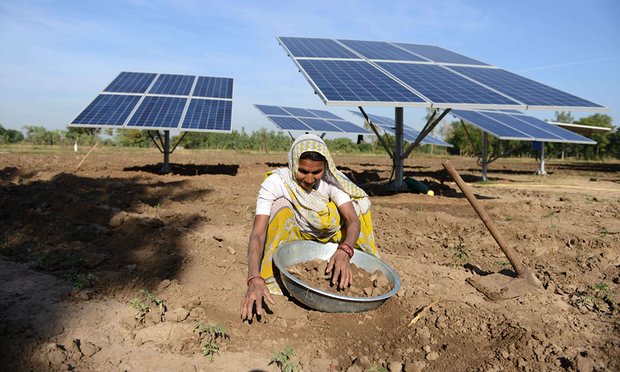
In the wake of the Covid 19 pandemic the crisis in Indian economy has accentuated and this deepening crisis has most adversely affected some of the poorest sections of society. While the need for government policy to deliver an adequate stimulus package for the economy is felt widely, there is wide difference of opinion regarding the precise form this should take. Half-hearted efforts such as those based on temporarily increasing the purchasing power of government employees for consumer goods certainly cannot go far. The economy needs a much more ambitious response with three essential features.
Firstly the stimulus should be such as to provide immediate livelihood and income support to the weaker sections as a core component which can be linked also to longer-term benefits for them. For this reason it should be labor-intensive and not capital-intensive. Secondly the works taken up under the stimulus should prioritize environment protection with a special focus on checking climate change as well as providing protection from its impacts. Hence another great priority can be linked to the pressing economic priority. Thirdly this effort on a massive scale should not be a stand-alone effort but should be possible to take forward this initiative in such a way that this can merge with and contribute much to improving future overall development.
These essential aspects should be respected in both rural and urban components of a great green stimulus.
In rural areas careful plans should be prepared involving ordinary villagers, community leaders, panchayats, local officials and activists regarding the most urgent needs for water conservation and water harvesting, rejuvenation of vanishing or endangered small streams, rivulets, ponds and other water sources, small-scale irrigation, drainage, regeneration of degraded land including pasture and forest land, protection of forests, tree-planting, protection from natural disasters, collection of traditional seeds, spread of agro-ecology approach, small-scale agro processing, social reform including gender equality and related aspects.
This should be on a scale which can provide significant livelihood support to about 50 million persons in the course of the implementation of the stimulus, while at the same time creating a strong base for many sustainable livelihoods in future. Most of the immediate livelihood support should be for landless or near landless households, although the entire village community will benefit from the overall improvement of environmental conditions.
A special focus should be on improving and greening of degraded land. A typical approach can be to make available a big stretch of degraded forest land to around a hundred landless or near landless villagers. They get livelihood support for building a protection wall around this and creating other conducive conditions for regeneration of natural forest, to be supported by additional planting of local species of trees where needed. The immediate livelihood and income support is generated in these activities. At the same time, initially villagers get grass and later they can get a lot of minor forest produce from the new forest. They can get rights over the forest regenerated by them ( the rights come with the responsibility of protecting forest). In addition to income from minor forest produce they can keep some dairy animals and cultivate small patches in and around the forest regenerated by them. Hence the initial employment provided by the stimulus package also leads to more permanent, sustainable, land ownership based livelihood for them in the longer-term.
Similarly degraded land which is suitable for agriculture and/or horticulture can be regenerated, starting with immediate generation of employment in regenerating land and leading later to more stable and permanent livelihoods.
Of course funding for all these works is already available under various government programs of various departments, but the actual achievement is poor as beyond the salaries and administrative costs funding support for actual work is poor, there is lack of linkages in various works and departments, comprehensive and longer-term planning is often missing in the routine-type approach, capability levels of planning and implementation are poor, there is very less involvement of local talents in planning and implementation and there is widespread corruption.
What a great green stimulus should seek to achieve is to try to overcome all these problems while also increasing funding for all these works and activities to a very substantial extent beyond the existing funds, while also taking steps to improve utilization of these funds in important ways.
Regarding the urban component the stimulus should contribute to greatly enhancing and improving, with greater and closer participation of people in planning and implementation, works relating to water conservation and water harvesting, protection of traditional water bodies with priority on endangered ones, riverside and floodplain improvements to increase water recharge and greenery, improvement of drainage, other steps to prevent sudden flooding, overall protection from disasters, more tree planting based on local species most suitable for area, decentralized sewage and waste management, digging/maintenance of compost pits , protection of diversity and better care of parks and green areas. This should be supported by social reform efforts including gender equality at various levels.
Here also additional employment for millions of people ( perhaps about 25 million people) from weakest sections should be created by the stimulus effort and creative efforts should be made to link these employments to longer-term livelihood opportunities, particularly in areas like creating cleaner and less polluting cities.
Such a stimulus cannot be seen as only a short-term effort but instead should have an adequately long span to be able to make an effective contribution. As its formal time span nears completion its various efforts should be integrated with regular activities and budgets so that no good initiative is disrupted or abandoned midway.
Such a stimulus will create large scale employment , income and purchasing power immediately among those who need this the most, thereby providing a tremendous boost to the overall economy which is also a very broad-based boost. This will help significantly to reduce inequalities. This will greatly help to improve environment protection , in particular to check climate change and greenhouse gas emissions while also contributing to better protection from climate change related and other disasters.
The writer is a freelance journalist who has been involved with several social movements.
SIGN UP FOR COUNTERCURRENTS DAILY NEWSLETTER

















































